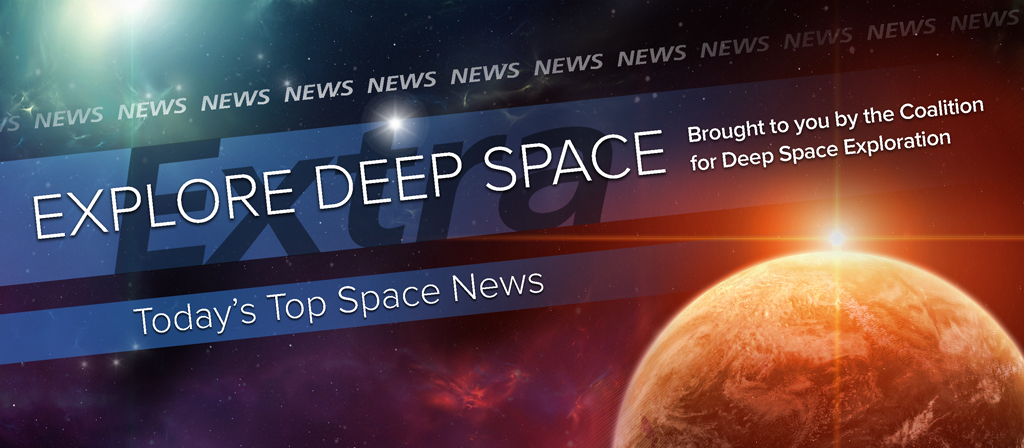In Today’s Deep Space Extra…This week’s Utah test firing of the Orbital ATK solid rocket motor assigned to NASA’s Space Launch System exploration rocket makes a powerful impression
Human Deep Space Exploration
An afternoon with the world’s most powerful rocket booster
Motherboard (6/29): Space vets cautioned ahead that Tuesday’s ear shattering ground test of the solid rocket motor developed for NASA’s Space Launch System exploration rocket would rattle fillings and cause loose clothing to wave in the wind. The warnings were true as the Orbital ATK rocket motor prepared for Exploration Mission-1, the first test flight of the SLM and Orion crew capsule planned for late 2018. The unmanned EM-1 test flight will take the capsule around the moon and back to Earth.
Space Science
How NASA’s Juno mission could help tell us where we came from
Washington Post (6/29): After a five-year journey through the solar system’s inner realm, NASA’s Juno probe is set to maneuver into orbit around giant Jupiter on July 4. Researchers hope Juno’s dynamic orbital mission will divulge not only more about the solar system’s largest planet but how it may have influenced the formation of the other planets. “Jupiter is a planet on steroids,” said principal investigator Scott Bolton, of the Southwest Research Institute. “Everything about it is extreme.”
Asteroid Day is a chance to learn about space and plan for disaster
Science News (6/29): Thursday marks a global recognition of “Asteroid Day,” an emerging reminder that an Earthly collision with a large planetary object could be catastrophic.
Mars’ atmosphere was likely more oxygen-rich long ago
Space.com (6/29): Concentrations of manganese oxides in Martian rocks detected by NASA’s Curiosity rover suggest the red planet’s atmosphere was richer in oxygen and water than the current environment. Curiosity landed in August 2012 in Mars’ Gale Crater and is currently scaling Mount Sharp.
Mistaken identity: Ceres’ mysterious bright spots aren’t epsom salt after all
Space.com (6/29): New analysis of the large asteroid Ceres by NASA’s Dawn mission spacecraft suggests the bright spots that illuminate the terrain are not comprised of an Epsom salt like chemistry after all. What’s more, rugged surface features once thought to be comprised of ice are more likely made of rock. The findings were published in the journals Nature and Nature Geoscience.
Meteorites from fireball seen over Arizona found
New York Times (6/30): Early on June 2, a fireball caught the attention of many in eastern Arizona. Now, researchers from Arizona State University say they have found 15 remnants of the meteor on tribal grounds on White Mountain.
Low Earth Orbit
Chinese intelligence-gathering satellite launched by Long March 4B rocket
Spaceflightnow.com (6/29): China launched an Earth-observingsatellite Wednesday atop a Long March 4B rocket from the Jiuquan Satellite Launch Center.
Commercial to Low Earth Orbit
Sierra Nevada’s Dream Chaser to provide access to space for countries worldwide
Spaceflight Insider (6/29): Under a memorandum of understanding with the United Nations Office for Outer Space Affairs, Sierra Nevada’s reusable Dream Chaser spacecraft will offer access to orbital space for member states that desire to conduct experiments. Sierra Nevada announced the agreement on Tuesday. The company was recently selected by NASA to launch supplies to the International Space Station using the winged Dream Chaser.
Airbus, Safran finalize space launchers merger
Reuters (6/29): In Europe, Airbus and Safran strike agreements to manufacture Europe’s new satellite launch vehicle, the Ariane 6. The inaugural launch is expected in 2020.
NASA negotiated discounts after SpaceX launch failure
Space News (6/29): NASA’s inspector general reports that NASA elicited launch cost reductions after SpaceX experienced a post liftoff failure of its Falcon 9 launch vehicle on June 28, 2015 with a cargo of supplies bound for the International Space Station. SpaceX was launching for the seventh time under a NASA space station re-supply contract.

